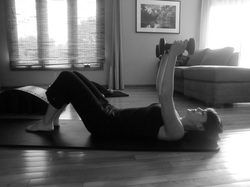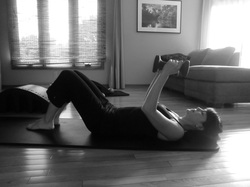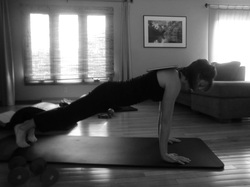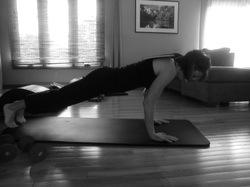How many push-ups can you do? Push-ups are like sit-ups, a part of most exercise programs. People often express, "I do 100 sit-ups a day but I can't lose this stomach pooch." Likewise, people may regularly do push-ups and find their upper body remains weak, triceps flabby, constant neck and shoulder tension, and their low back feels strained. As I continue to immerse myself in Pilates, ongoing education, as well as 1:1 mentorships I remain convinced that Joseph Pilates was a genius in his assessment and application of movement to create a strong and balanced body. One of my current personal focal areas is improving the strength and position of my shoulder blades in relation to my torso. Mine are slightly asymmetrical with a "winging" of the right blade typical of mid-scapula muscle weakness. Weakness in this region affects shoulder mobility, strength and function increasing ones risk of rotator cuff injuries and shoulder impingement syndromes. So when we think of creating a balanced body and preventative maintenance, strengthening the muscles connecting to the scapula is of value.
This past week when I met with my Pilates coach, Dylann, I asked her about techniques she uses to improve the resting position of a client's scapula on the rib-cage. In the process she gave me some great tips to help a diverse population. Today I used some of her techniques on one of my most fit and knowledgeable clients, Anne. At the end of our plank and push-up practice even Anne said, "Wow, I can't believe how long I have been cheating on my push-ups!"
My good friend Anne, an incredible physical therapist, was here this morning for a 1:1 Pilates session. I demonstrated to her the method of first "puffing out" between the center of the shoulder blades as if doing a "push-up plus" motion so that you get greater separation of the shoulder blades expanse over the back. Holding that position, without losing that stability between the blades, begin to bend your elbows close to your body...don't let the shoulder blades pinch and retract nor allow the shoulders to jam in toward the ears. Maintain length in the back of the neck, keep the sternum and head lifted...if you sag then you have lost your vertical axis or line which extends from the crown of the head to the tailbone. As you do this version of a push up, you might find you get minimal range of motion however substantial recruitment through the triceps, lats, and rhomboids. It becomes much less of a chest/anterior shoulder exercise and more of a 360 degree shoulder girdle/scapular stabilization motion thus creating a balance between the tighter front muscles of the chest and the weaker, overstretched muscles of the upper back.
This past week when I met with my Pilates coach, Dylann, I asked her about techniques she uses to improve the resting position of a client's scapula on the rib-cage. In the process she gave me some great tips to help a diverse population. Today I used some of her techniques on one of my most fit and knowledgeable clients, Anne. At the end of our plank and push-up practice even Anne said, "Wow, I can't believe how long I have been cheating on my push-ups!"
My good friend Anne, an incredible physical therapist, was here this morning for a 1:1 Pilates session. I demonstrated to her the method of first "puffing out" between the center of the shoulder blades as if doing a "push-up plus" motion so that you get greater separation of the shoulder blades expanse over the back. Holding that position, without losing that stability between the blades, begin to bend your elbows close to your body...don't let the shoulder blades pinch and retract nor allow the shoulders to jam in toward the ears. Maintain length in the back of the neck, keep the sternum and head lifted...if you sag then you have lost your vertical axis or line which extends from the crown of the head to the tailbone. As you do this version of a push up, you might find you get minimal range of motion however substantial recruitment through the triceps, lats, and rhomboids. It becomes much less of a chest/anterior shoulder exercise and more of a 360 degree shoulder girdle/scapular stabilization motion thus creating a balance between the tighter front muscles of the chest and the weaker, overstretched muscles of the upper back.

First, to find the feeling of your shoulder blades in a neutral position, hold a set of hand weights with your wrists aligned over your shoulders. I am using 8# weights. Let the weights sink the humerus into the shoulder socket and notice how square and flat your shoulders feel to the earth. This shoulder compression alone feels good to the body as it allows gravity to assist us in expanding the front of the chest. Technically, as I look at this picture I could have my elbows straighter to improve the line between my wrist and shoulders.

Now, keep this comfortable, flat, stable position of the shoulder blades intact as you imagine the motion involved in doing a tricep push-up. Without disturbing any of the width of the shoulder blades or openness of the front of the chest and shoulders, begin to bend your elbows. Keep them close to your sides. Notice how your scapula might want to retract or pinch, the front of your shoulders may want to round. By doing this pre-exercise to planks and push-ups we experience a sense of stability within the shoulder blades, partly given simply by resting them flat on the ground. In addition we tune in to muscular timing. Notice how as you bend the elbows there may be a tendency of your sternum to push toward the ceiling. Use your core muscles and connect the ribcage together and down. In the actual plank position this release of the core causes us to sag the sternum, hang the head, and arch the low back...a very poor position to actually call it a strength building exercise. By keeping a lift of the sternum we maintain a healthy line of the thoracic spine.

Now, flip over to a plank position. Anne place a book on my back to simulate the constant feeling of my shoulder blades in contact with the floor. You could use a yard stick or any flat, rectangular item to give you feedback of level shoulder blades in the pushup position. I have to work hard to lift my sternum into my mid-back and "puff up" between the shoulder blades. I am protracting my scapula slightly, with energy pushing up and away from the floor. Be conscious of not letting the cervical vertebrae sag--keep drawing or lifting the throat to the back of the neck in Pilates-speak so that the back of the neck stays long and lengthened.

Now, add the elbow bend...the tricep push-up part of the exercise. Can you do this without losing the width of the blades and minimizing heavy chest/pec/shoulder activity? Isolate into the back of the arms..the triceps and lats region while still puffing up between the shoulder blades. We don't want to sag into the shoulder and shoulder blades. Continue to lift the sternum/breastbone to avoid arching your thoracic spine. I am actually working quite hard here with a very small elbow bend. Only take the position as far as you can maintain scapula, spine and pelvis position. I'm sure if Anne had taken one more picture my elbows would have been bent at 90 degrees and hugging into my sides (well, probably not but I'm working at it) Remember, with a true tricep pushup you want to feel your elbows touching your ribcage.
Special thanks to Dylann at Pewaukee Movement Center for her helpful tips and suggestions. To be a good instructor we also have to be willing and committed to being students. Pilates is a practice that is enhanced with close observations and verbal and tactile cues...the more we know the more we have to learn. Thank you as well to Aurora Physical Therapist Anne. I am grateful for her willingness to play today and connect the pieces from her experienced and thorough biomechanical perspective.
Enjoy the weekend!
Special thanks to Dylann at Pewaukee Movement Center for her helpful tips and suggestions. To be a good instructor we also have to be willing and committed to being students. Pilates is a practice that is enhanced with close observations and verbal and tactile cues...the more we know the more we have to learn. Thank you as well to Aurora Physical Therapist Anne. I am grateful for her willingness to play today and connect the pieces from her experienced and thorough biomechanical perspective.
Enjoy the weekend!
 RSS Feed
RSS Feed